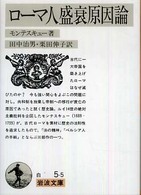- ホーム
- > 洋書
- > 英文書
- > History / American
基本説明
The first anthropological study of the long-term consequences of the Manhattan Project for the people that live in and around Los Alamos, New Mexico, where the first atomic bomb, and the majority of weapons in the current U.S. nuclear arsenal, were designed.
Full Description
"The Nuclear Borderlands" explores the socio-cultural fallout of twentieth-century America's premier technoscientific project - the atomic bomb. Joseph Masco offers the first anthropological study of the long-term consequences of the Manhattan Project for the people that live in and around Los Alamos, New Mexico, where the first atomic bomb, and the majority of weapons in the current US nuclear arsenal, were designed. Masco examines how diverse groups - weapons scientists at Los Alamos National Laboratory, neighbouring Pueblo Indian Nations and Nuevomexicano communities, and antinuclear activists - have engaged the US nuclear weapons project in the post-Cold War period, mobilizing to debate and redefine what constitutes 'national security'.In a pathbreaking ethnographic analysis, Masco argues that the US focus on potential nuclear apocalypse during the Cold War obscured the broader effects of the nuclear complex on American society. The atomic bomb, he demonstrates, is not just the engine of American technoscientific modernity; it has produced a new cognitive orientation toward everyday life, provoking cross-cultural experiences of what Masco calls a 'nuclear uncanny'.Revealing how the bomb has reconfigured concepts of time, nature, race, and citizenship, this book provides new theoretical perspectives on the origin and logic of US national security culture. "The Nuclear Borderlands" ultimately assesses the efforts of the nuclear security state to reinvent itself in a post-Cold War world, and in so doing exposes the nuclear logic supporting the twenty-first-century US war on terrorism.
Contents
List of Illustrations vii Acknowledgments xi Chapter 1ENLIGHTENED EARTH 1 The Nuclear State of Emergency 5 Radioactive Nation-building 18 The Nuclear Uncanny 27 "A Multidimensional, Nonlinear, ALAMOS 43 The Bomb's Future 46 Above-ground Testing (1945-1962): Tactility and the Nuclear Sublime 55 Underground Testing (1963-1992): Embracing Complexity, Fetishizing Production 68 Science-Based Stockpile Stewardship (1995-2010): Virtual Bombs and Prosthetic Senses 78 Of Bombs and Bodies in the Plutonium Economy 96 Chapter 3: ECONATIONALISMS: FIRST NATIONS IN THE PLUTONIUM ECONOMY 99 Ecologies of Place 101 The New World: 1942/1992 112 Mirrors and Appropriations: The Secret Societies of the Pajarito Plateau 119 Explosive Testing 132 Nuclear Nations: The Sovereignty of Nuclear Waste 144 Econationalisms in the Plutonium Economy 156 Chapter 4: RADIOACTIVE Radioactive Death Trucks 162 On Invasion and Illegitimacy 179 LANL: A Nuclear Maquiladora? 197 Nuevomexicano Futures in the Plutonium Economy 213 of Plutonium 228 Anti-antinuclear Activists 237 What Is a "New" Nuclear Weapon? 244 Los Alamos: Ground Zero of the Peace Movement 256 PART II: NATIONAL INSECURITIES 261 Chapter 6: LIE DETECTORS: ON SECRECTS AND Profiling 272 Hypersecurity Measures 278 The "New Normal" 283 Chapter and Ants 293 Nuclear Test Subjects 302 The Wildlife/Sacrifice Zone 311 Environmental Sentinels, or the Militarization of the Honey Bee 316 The Social Logics of Mutation 324 Chapter 8: EPILOGUE: THE NUCLEAR BORDERLANDS 328 Notes 339 References 375 Index 413





